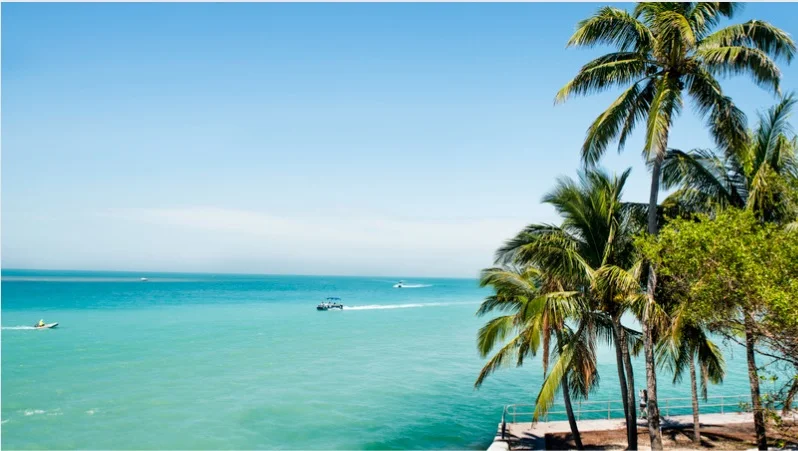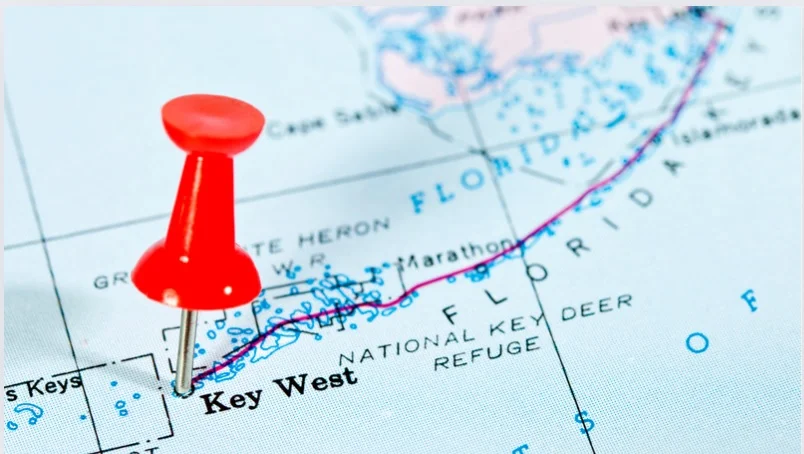The Florida Keys, a coral cay archipelago off the southern coast of Florida, form the southernmost part of the continental United States. This chain of islands, with its unique geography and rich history, stretches from the southeastern coast of the Florida peninsula, approximately 15 miles south of Miami, extending in a gentle arc south-southwest and then westward to Key West, the westernmost of the inhabited islands, and further to the uninhabited Dry Tortugas. Situated between 24.3 and 25.5 degrees North latitude, the Keys lie along the Florida Straits, creating a natural division between the Atlantic Ocean to the east and the Gulf of Mexico to the northwest, while also defining the northern boundary of Florida Bay.
Geographic Significance
The Florida Keys are an ecological treasure trove, featuring a unique marine environment. The islands themselves are composed of ancient coral reef formations and oolitic limestone. The region’s subtropical climate and the warm waters of the Gulf Stream support a diverse range of marine life, including vibrant coral reefs, which are among the only living coral barrier reefs in the continental United States. This distinctive marine ecosystem makes the Keys a premier destination for snorkeling, scuba diving, and fishing enthusiasts.
Key West, the most famous of the Keys, lies 93 miles from Cuba, making it a strategic point of contact between the U.S. and its Caribbean neighbor. The proximity to Cuba has historically influenced the culture and economy of the Keys, fostering a blend of American and Caribbean influences that is evident in the local architecture, cuisine, and traditions.
Historical Background
Long before European exploration, the Florida Keys were inhabited by the Calusa and Tequesta tribes. These indigenous peoples thrived in the region, utilizing the abundant marine resources for sustenance and trade. The first recorded European contact with the Keys occurred in 1513 when Spanish explorer Juan Ponce de León charted the islands. He named them Los Martires (“The Martyrs”) due to their appearance from a distance, which he thought resembled suffering men.
The name “Key” is derived from the Spanish word “cayo,” meaning small island. This term was adopted by English-speaking settlers and has been used ever since to describe the islands in the archipelago. During the early years of European colonization, the Keys served as a critical navigational point for ships traveling between the Gulf of Mexico and the Atlantic Ocean.
Key West: A Historical Hub
Key West, the largest and most historically significant of the Florida Keys, was for many years the largest town in Florida. The island’s strategic location made it a hub for trade with Cuba and the Bahamas. During the 19th century, Key West prospered significantly due to its wrecking revenues. The treacherous waters surrounding the Keys led to numerous shipwrecks, and local residents, known as “wreckers,” salvaged goods from these wrecks, generating substantial income.
As navigation improved and shipwrecks became less frequent, Key West’s economy began to decline in the late 19th century. However, the island remained a significant outpost due to its strategic military importance and its cultural connections with the Caribbean.

Modern Development and Tourism
In the 20th century, the construction of the Overseas Highway transformed the Florida Keys. Completed in 1938, this engineering marvel connected the mainland to Key West via a series of bridges and causeways, opening the islands to tourism and development. The highway, which follows the route of the former Overseas Railroad built by Henry Flagler in the early 1900s, made the Keys accessible to motorists, leading to a tourism boom that continues to this day.
Today, tourism is the primary economic driver in the Florida Keys. Visitors are drawn to the islands’ natural beauty, outdoor recreational opportunities, and rich cultural heritage. The Keys are renowned for their vibrant arts scene, historic sites, and annual festivals, such as Fantasy Fest in Key West, which attract visitors from around the world.
Environmental Conservation
The unique ecosystem of the Florida Keys is fragile and faces numerous environmental challenges. Rising sea levels, coral bleaching, and habitat loss are significant threats to the region’s biodiversity. Conservation efforts are critical to preserving the natural beauty and ecological health of the Keys. The Florida Keys National Marine Sanctuary, established in 1990, plays a vital role in protecting the marine environment. This sanctuary encompasses 2,900 square nautical miles of coastal and ocean waters, providing a framework for managing and conserving the region’s natural resources.
Cultural and Recreational Highlights
The Florida Keys offer a rich cultural tapestry influenced by their proximity to the Caribbean and their history as a crossroads of trade and migration. The islands are known for their laid-back atmosphere, vibrant music scene, and eclectic art galleries. Key West, in particular, has been a haven for writers and artists, with notable residents including Ernest Hemingway and Tennessee Williams.
Outdoor enthusiasts flock to the Keys for a variety of recreational activities. The region’s clear waters and coral reefs make it a premier destination for diving and snorkeling. Anglers are drawn to the abundant fishing opportunities, with species such as tarpon, bonefish, and marlin attracting sport fishermen from around the globe. Boating, kayaking, and eco-tours are also popular, offering visitors a chance to explore the natural beauty of the islands up close.
Conclusion
The Florida Keys, with their unique blend of natural beauty, rich history, and vibrant culture, are a treasure of the southern United States. From the indigenous Calusa and Tequesta tribes to the Spanish explorers and modern-day tourists, the Keys have long captivated those who visit them. As the islands continue to face environmental challenges, ongoing conservation efforts are essential to preserving this unique archipelago for future generations to enjoy. The Florida Keys remain a testament to the enduring allure of small islands and the rich tapestry of history and culture they hold.









